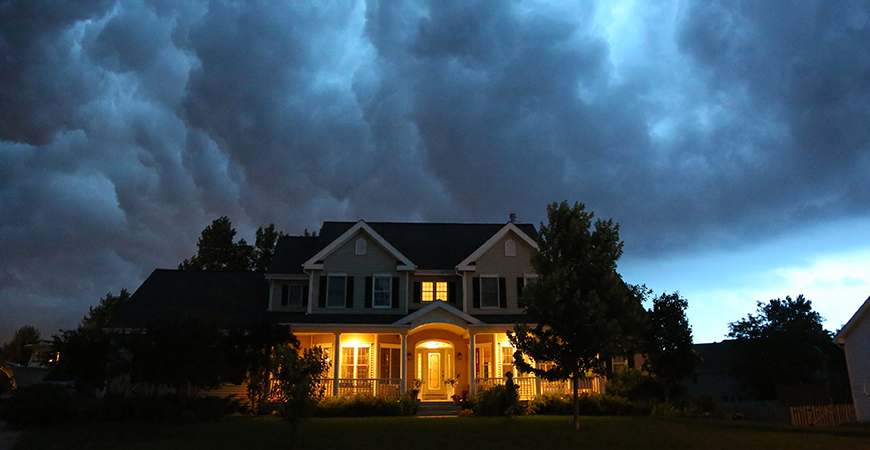How to Protect Your Home from Severe Weather
posted
on Tuesday, August 4, 2020
in
Education

Many parts of the country experience strong storms in late summer and throughout the fall. Heavy rain, strong winds, and other powerful forces of nature can do serious damage to your property in a very short time. Before storm season hits, take action to prevent bad things from happening by checking off the items on this list, rather than waiting to assess damage when the storms are over.
While these preventive steps can't eliminate your risk, they can help minimize the damage when severe weather hits.
Keep Your Lawn Clear
Flying debris is dangerous! Be sure to pick up and securely store gardening tools and supplies, outdoor furniture and décor, dead tree limbs, and other clutter that could go flying through a window or door.
Trim The Trees
One crack of lightning or a gale-force wind can bring down large limbs and branches right onto your roof, through your windows, or onto your vehicles. Any dead trees should be removed immediately, since a withered root system could allow the entire thing to uproot and crash down. You’ll have more to worry about than just your roof if that happens.
Give Your Roof A Checkup
Replace any loose shingles or tiles, and check that your flashing is attached firmly. Metal roofing may have lifted at the edges and need to be secured. If you have an accessible attic or crawl space, you can check for leaks, mold, and damage to the underside of the roof yourself. Sure, your roof is built to be durable and long-lasting, but the weather can really do a number on it if you’re not maintaining it during the off season.
Replace Loose Siding
Wind, hail, and airborne items can all damage your siding. Cracks and chips need to be addressed, while holes and breakage should be inspected by a professional. Paint, stucco, and bricks can all be damaged by severe weather as well.
Seal Or Upgrade Windows & Doors
Check your weatherstripping and make sure it’s not damaged or peeling off. Preventing water and wind from rushing through your house means you’ll have less mess to clean up when the storm subsides. If you need to have sheets of plywood, hurricane film, or storm shutters on hand, get them and be sure you know how to install them properly. (Note: duct taping Xs on your windows does not work!) You could also upgrade to high-impact glass that cracks into spiderwebs, much like your car’s windshield, instead of shattering.
Note: According to Keller Roofing & Inspections, you must keep your doors and windows tightly closed during a storm, or you could damage your roof. If a door or window flies open, it can change the air pressure in your home and ever-so-slightly lift your roof, weakening the whole structure.
Brace The Garage Door
If your budget won’t allow for a new impact-resistant or hurricane-proof garage door ($750-$1,300), then a bracing kit may be the way to go. It includes everything you need except the tools and costs around $500 if you have a double door. Bracing kits add reinforcements to the door itself as well as the tracks.
Clean & Check The Gutters
Leaves and other debris that block the gutters can be swept into the downspouts, damaging them. Rainwater with nowhere to go can back up onto the roof and puddle there, weakening the whole thing, or flood around the foundation of your home, causing structural damage. Check that your downspouts are securely attached and carry water away from your house.
Reinforce Structural Elements
Earthquakes are becoming more prevalent across the country, in areas that may never have felt them before. They can cause your house to move or shift on its foundation, which is a very bad thing. Luckily, you can actually anchor your home to the foundation with steel plates to mitigate the damage. Reinforcing the cripple wall, which helps support the house and creates your crawl space, and bracing chimneys are also recommended as preventative measures.
Secure Possessions
When severe weather strikes, it’s a good idea to have tall furniture and appliances anchored so your bookshelves and cabinets don’t come crashing down, possibly injuring the people inside your home and damaging your possessions. Your water heater also should be secured. Add ledge barriers to shelves, place heavier items on lower shelves, and install latches on cabinet and cupboard doors to help reduce the breakage inside your home.
One Last Bit Of Advice...
Review your insurance coverage so that you know what's covered and how to file a claim. Most homeowners insurance does not include flooding, so you may need supplemental coverage. It's one less chore to do when calm has returned and you're checking for damages. You'll be glad you did!
Note: Get the insurance coverage you need this year from a name you trust! You can get a free no obligation quote from Northwest Insurance Services today for your home, auto, boat, RV and much more! Call 844-445-9276 or go online at NorthwestBankInsurance.com and start your quote today!
Insurance Products are not insured by FDIC or any Federal Government Agency; are not a deposit of, or guaranteed by the Bank or any Bank Affiliate; and may go down in value.
If you need to make some upgrades to your home for storm safety, contact a Northwest Bank Mortgage Banker today to learn about financing that may be available to you.